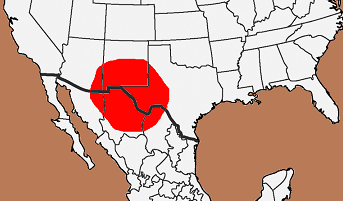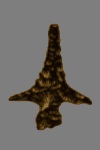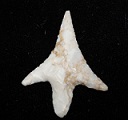Outline is Representative of Size and Shape:

Name Details:
Identified By: Charles Kelly, Thomas N. Campbell, Donald Lehmer / Further described by Suhm and Kreiger
Named For: Mount Livermore, Trans-Pecos of Texas, Jeff Davis County, Texas
Date Identified: 1940 / 1954
Type Site:
Identified By: Charles Kelly, Thomas N. Campbell, Donald Lehmer / Further described by Suhm and Kreiger
Named For: Mount Livermore, Trans-Pecos of Texas, Jeff Davis County, Texas
Date Identified: 1940 / 1954
Type Site:
Point Validity:
Valid type
Kelly was a distinguished anthropologist who conducted extensive studies into the Big Bend region of Texas. He served as Curator for the University of Texas – Austin’s Museum of Anthropology before moving to Illinois to direct the University of Southern Illinois’s Museum of Anthropology. Campbell is a prominent anthropologist and professor emeritus at the University of Texas. Lehmer was an eminent anthropologist and and professor at the University of Washington. This type was named in a professional publication and has many professional references. This is considered a valid type.
Livermore Stemmed
Cluster: Livermore Stemmed Cluster Description of Physical Characteristics and Flaking Pattern:
This is a small medium stemmed point with a flattened to elliptical cross section. The blade is incurvate, flaring out at the shoulders edge. Examples with exaggerated flaring blades have a cross appearance. The blade is commonly deeply serrated. The shoulders are broad and most commonly barbed, but may vary to a downward slope to horizontal. The stem is primarily straight, but may range from slightly contracting to slightly expanding. The base may range from straight to convex. Points with a convex base may have a stem with a bulbous appearance. This point has a random flaking pattern.
Size Measurements:
Total Length - 21 to 50 mm, Blade Width - 5 to 10 mm, Shoulder Width - 12 to 30 mm, Stem Width, 4 to 10 mm, Thickness - 4 to 7 mm
Total Length - 21 to 50 mm, Blade Width - 5 to 10 mm, Shoulder Width - 12 to 30 mm, Stem Width, 4 to 10 mm, Thickness - 4 to 7 mm
Commonly Utilized Material:
Additional Comments:
This point is similar to the Neff point, however the Neff type has more of an expanding stem than commonly seen on the Livermore type. The overlapping characteristics may make these two types difficult to distinguish between.
This point is similar to the Neff point, however the Neff type has more of an expanding stem than commonly seen on the Livermore type. The overlapping characteristics may make these two types difficult to distinguish between.
Distribution:

Distribution Comments:
This point is primarily found in the Trans-Pecos region of Texas and Chihuahua. This point may be found into the Midland Texas region and throughout the Guadalupe Mountains. This point may be found with decreased frequency into southeastern Arizona.
This point is primarily found in the Trans-Pecos region of Texas and Chihuahua. This point may be found into the Midland Texas region and throughout the Guadalupe Mountains. This point may be found with decreased frequency into southeastern Arizona.
Age / Periods:
Date: 1,200 - 800 B.P.
Cultural Period: Developmental - Prehistoric
Glacial Period: Vandal Minimum to Medieval Warm
Culture:
Phase:
Date: 1,200 - 800 B.P.
Cultural Period: Developmental - Prehistoric
Glacial Period: Vandal Minimum to Medieval Warm
Culture:
Phase:
Age Details:
Suhm et al. (1954) state this is a major type of the Livermore Focus extending intrusively into the Jornada Branch of New Mexico.
Suhm et al. (1954) state this is a major type of the Livermore Focus extending intrusively into the Jornada Branch of New Mexico.






